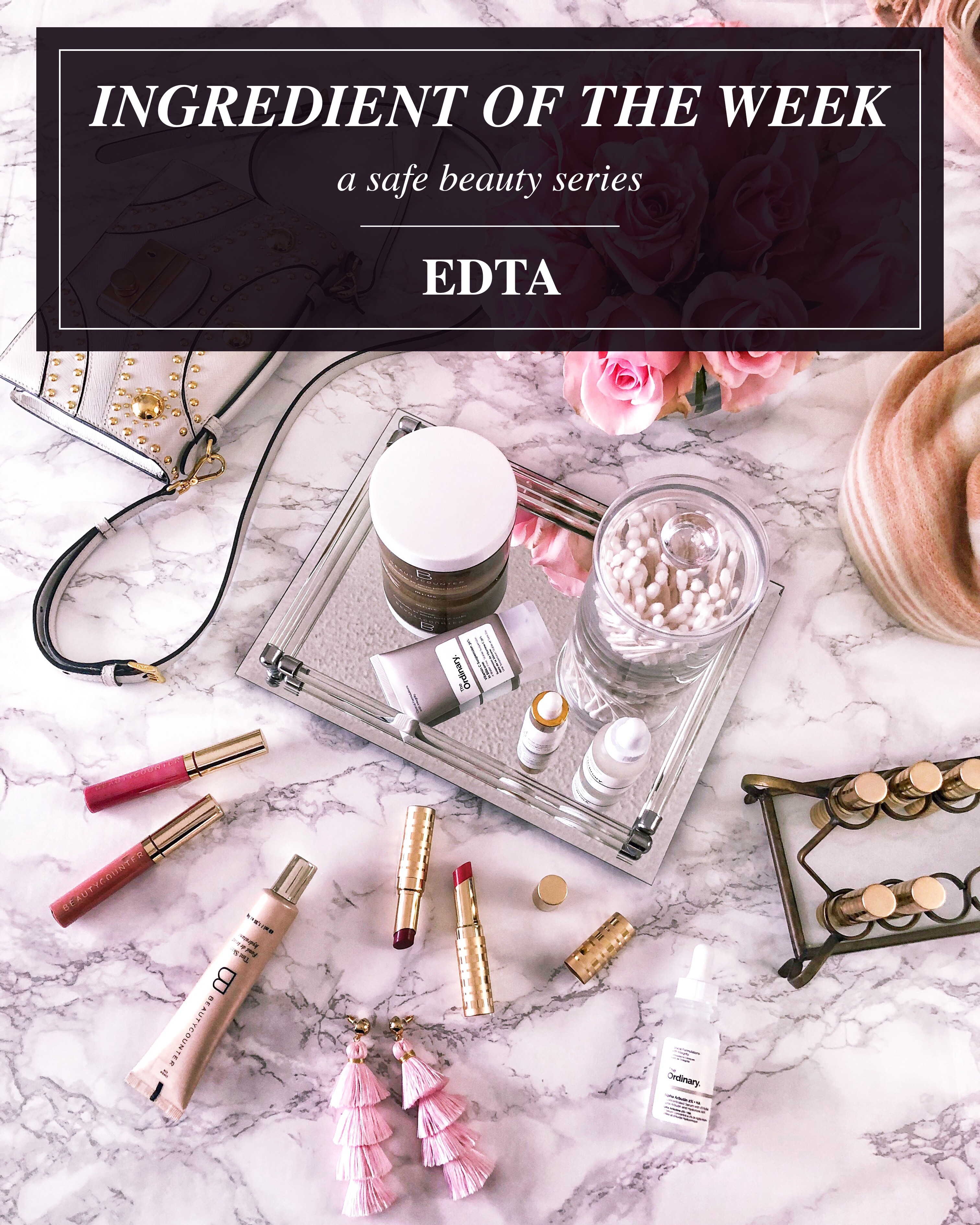
For this week’s Ingredient of the Week post I’m talking about EDTA. This is an ingredient that I’ve been seeing a lot lately on labels so I wanted to learn more about it.
If you missed the intro to this series, it explains what “safe beauty” is, and why it’s important. The quick version is that the FDA doesn’t regulate what chemicals brands put in their products and it doesn’t set standards for words like “natural” or “organic”. Basically, a brand could put “natural” on a container full of carcinogens if they wanted (and they often do). I caveat this at the beginning of every post not to scare anyone but to educate. You don’t have to switch everything you own to safer today. Just make small changes where it makes sense for you. After all, doing something is better than doing nothing, right?
If you’re completely overwhelmed right now, take a look at my skincare routine and my everyday makeup routine. Since most of the products we use fall into one of those two categories, it will give you an idea of some great beauty products to start with. Of course, if you have any questions, shoot me an email or send me a DM. I chat with you guys all day long about personalized recommendations based on your needs! If you want more, here’s a list of my favorite beauty products!
What to look for.
This one is a little tricky as most of the time EDTA comes after another chemical. What I wanted to know was if EDTA alone was bad but something like Disodium EDTA was safe to use.
Calcium Disodium EDTA
Diammonium EDTA
Dipotassium EDTA
Disodium EDTA
EDTA
Ethylenediaminetetraacetic acid
HEDTA (hydroxyethyl ethylenediamine triacetic acid)
TEA-EDTA
Tetrasodium EDTA
Tripotassium EDTA
Trisodium EDTA
Trisodium Salt
Trisodium HEDTA
What is EDTA?
Ethylenediaminetetraacetic acid (EDTA) is a binding agent and the other ingredients listed above are salts of EDTA. They counteract the effects of hard water and heavy metals by binding with metal ions so they aren’t as likely to be deposited onto you (EDTA isn’t easily absorbed by the skin). This also makes the remaining ingredients in the product more effective. I thought it was interesting to learn that EDTA was formulated with formaldehyde. I know that it’s just chemistry but that was gross.
Why do brands use EDTA?
EDTA prevents the deterioration, increases effectiveness, and improves the stability of beauty products. It basically makes a product last longer, reducing costs of the brand because they don’t have to replace product that has expired or gone bad. It also disrupts the surface of your skin so that other ingredients in the product can be absorbed better. If any of the other chemicals in a product are toxic, that’s bad news. When combined with other chemicals, the product can foam better or its cleaning ability can be more effective.
What products contain EDTA?
Just about everything. There’s edta dry shampoo sprays, hair dye, night cream, face serum, eye creams, and edta powders. I most recently found this ingredient in TULA products!
What EDTA can do to you.
In this case, it’s not necessarily EDTA that’s harmful to you but the other chemicals in a product that has EDTA in it. EDTA alone is approved for use by the FDA in low dosages since it is minimally absorbed by the skin. If you see this on a label, make sure to read through the rest of this list to ensure whatever product you’re looking at doesn’t contain any of it. For me personally, I’d rather not take the risk.
I also found that EDTA is used in food. WebMD has a long list of side effects including anemia, blood clots, irregular heartbeats, and insulin shock. Yikes.
Skin irritants. Some people have experienced eczema breakouts after exposure to Tetrasodium EDTA which is also an eye irritant.
Reproductive and developmental effects. Increased or long term exposure to EDTA used orally and not topically has led to reproductive and developmental effects. It’s mildly mutagenic. So, watch out for this ingredient in anything you use around your mouth or any dry shampoos/aerosol sprays that you might inhale. Even though studies show oral consumption does the most damage, I always look out for words like “usually”.
Safe alternatives to EDTA.
Since EDTA is in so many chemicals, it’s best to stick to safer brands which don’t use them. My favorite brands right now are Beautycounter and RMS Beauty although I did order a bunch of new products from the Sephora and Dermstore sales.
Have you used anything that contains EDTA or one of its salts? Do you have any favorite safe beauty products of any kind? Leave your recommendations below – I always love getting new beauty tips!
I recently have been loving Mary Kay’s eye makeup remover. But after researching ingredients (wish I had come across your page sooner, but it’s okay because i’m learning now!) I see it contains Disodium EDTA and Dipotassium. Ugh! I’m almost finished with this bottle and am definitely going to switch over to the beauty counter one. Just an FYI for others out there..
Thank you for letting us know!! Don’t worry too much – one bottle won’t harm you TOO much! It’s more long term exposure + having these ingredients in all 5-20 products you put on your face before you leave the house every morning!
Nice post